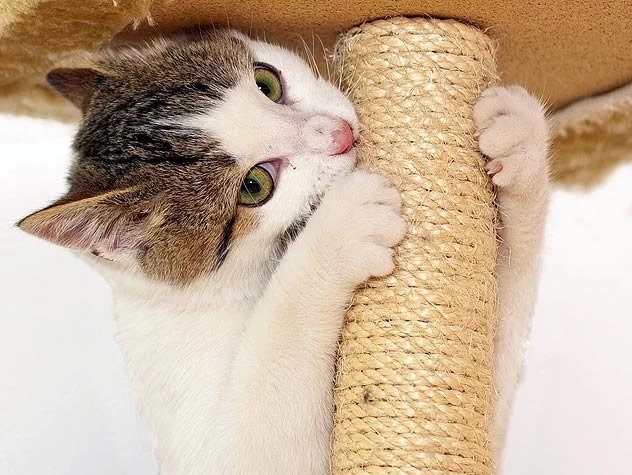
- Understanding Your Kitten's Scratching Behavior
- Choosing the Right Scratching Pad for Your Kitten
- Step-by-Step Guide to Training Your Kitten to Use a Scratching Pad
- Common Mistakes to Avoid During Scratching Pad Training
- Real-Life Story: How One Kitten Learned to Use a Scratching Pad
Understanding Your Kitten's Scratching Behavior
Scratching is a natural and essential behavior for kittens and adult cats alike. It serves several purposes: it helps kittens stretch their muscles, marks their territory, and keeps their claws healthy. Unfortunately, this instinctive behavior often leads to unwanted scratching on furniture, carpets, and other household items.
To address this, it’s important to redirect their scratching behavior onto appropriate surfaces like scratching pads. Understanding why kittens scratch is key to successful training. By providing the right tools and being patient, you can teach your kitten to focus their scratching efforts on the designated area, rather than your furniture.
Choosing the Right Scratching Pad for Your Kitten
Choosing the right scratching pad is crucial to successful training. Not all kittens will be attracted to the same type of scratching surface. Here are some factors to consider when selecting a scratching pad for your kitten:

Pisces Fish and Coral
Rancho CucamongaSan Bernardino CountyCalifornia
9255 Base Line Rd suite q, Rancho Cucamonga, CA 91730, USA
1. Material
Scratching pads come in various materials, including cardboard, sisal, and carpet. Sisal pads are popular because they are durable and provide a satisfying texture for kittens. Cardboard scratching pads are another great option, as they are often cheaper and easy to find. Experiment with different materials to see what your kitten prefers.
2. Shape and Size
Scratching pads come in different shapes, such as flat, angled, or vertical. Kittens may prefer one style over another, so it’s a good idea to try a variety of shapes to see what suits your kitten’s natural scratching instincts. Also, consider the size of the pad—ensure it’s large enough to accommodate your kitten as they grow.
3. Placement
The placement of the scratching pad is equally important. Place it in areas where your kitten already enjoys scratching, like near furniture or along the walls. Ensure the pad is easily accessible and placed at a height that encourages scratching. For vertical scratchers, a tall scratching post or pad may be ideal.
Step-by-Step Guide to Training Your Kitten to Use a Scratching Pad
Training your kitten to use a scratching pad requires patience and consistency. Follow these steps to guide your kitten through the process:
1. Introduce the Scratching Pad Early
Introduce the scratching pad as soon as you bring your kitten home. Kittens are more likely to form habits early, so the sooner they associate the scratching pad with positive behavior, the better. Place the pad near areas where your kitten enjoys scratching, like next to the sofa or by the door.
2. Use Positive Reinforcement
When your kitten uses the scratching pad, reward them immediately with praise, a treat, or affection. Positive reinforcement will help your kitten associate the scratching pad with something enjoyable. Consistently rewarding good behavior is key to reinforcing the habit.
3. Redirect Unwanted Scratching
If your kitten starts scratching an inappropriate area, gently redirect them to the scratching pad. You can do this by gently picking them up and placing them on the pad, or by using a toy to entice them to the right spot. Never punish your kitten for scratching, as this can cause stress and hinder the training process.
4. Make the Scratching Pad Appealing
To make the scratching pad more attractive, consider using catnip or sprinkle some treats around the pad to entice your kitten. Some scratching pads even come with built-in catnip to make them irresistible. This can help your kitten associate the scratching pad with a fun, rewarding activity.
5. Be Patient and Consistent
Training takes time, so don’t expect immediate results. It’s essential to be patient and consistent with the process. Over time, your kitten will learn to use the scratching pad as their go-to place for scratching.
Common Mistakes to Avoid During Scratching Pad Training
Training your kitten to use a scratching pad can be challenging, especially if you’re not aware of common mistakes. Avoid the following pitfalls to ensure a smooth training process:
1. Not Providing Enough Options
If your kitten isn't interested in the first scratching pad you provide, don't give up. Kittens can be picky, so try different types of scratching pads or posts. Offering multiple options in different locations will give your kitten more chances to develop the right habit.
2. Using Punishment
Never punish your kitten for scratching the wrong areas. Cats respond poorly to punishment and it can damage the bond you share with them. Instead, focus on redirecting their behavior with positive reinforcement.
3. Not Rewarding the Behavior
Failing to reward your kitten when they use the scratching pad can slow down the training process. Always offer praise or treats immediately after your kitten scratches the pad to reinforce the behavior.
Real-Life Story: How One Kitten Learned to Use a Scratching Pad
When Sarah adopted her kitten, Luna, she found that Luna was scratching everything—her furniture, curtains, and even the walls. Sarah was frustrated but decided to try training Luna to use a scratching pad. She started by placing a sisal scratching post near Luna’s favorite scratching spots. Each time Luna scratched the post, Sarah rewarded her with a treat and affection.
Initially, Luna was more interested in scratching the couch, but after a few weeks, she began using the scratching pad regularly. Sarah continued to praise Luna each time she used the pad, and eventually, Luna stopped scratching the furniture altogether. Sarah’s patience and consistency paid off, and Luna now happily uses her scratching pad as intended.
This experience shows that with the right training techniques, patience, and consistency, you can teach your kitten to use a scratching pad and protect your furniture from unwanted damage.
Training your kitten to use a scratching pad doesn’t have to be a stressful experience. By choosing the right scratching pad, reinforcing positive behavior, and being patient, you can help your kitten develop the proper scratching habits. For all your kitten training needs, including scratching pads and other supplies, visit Omnia Pet for the best products and advice.








 LA Quality Pet Care Animal Clinic (Formerly Estafanous W DVM)4.0 (19 reviews)
LA Quality Pet Care Animal Clinic (Formerly Estafanous W DVM)4.0 (19 reviews) Banfield Pet Hospital4.0 (50 reviews)
Banfield Pet Hospital4.0 (50 reviews) Banfield Pet Hospital4.0 (59 reviews)
Banfield Pet Hospital4.0 (59 reviews) Glens Falls Animal Hospital4.0 (624 reviews)
Glens Falls Animal Hospital4.0 (624 reviews) Hueneme Veterinary Center4.0 (79 reviews)
Hueneme Veterinary Center4.0 (79 reviews) Sea Girt Animal Hospital4.0 (434 reviews)
Sea Girt Animal Hospital4.0 (434 reviews) Why Is My Dog Panting So Much? Normal Behavior vs. Emergency
Why Is My Dog Panting So Much? Normal Behavior vs. Emergency The Best Dog Names of 2024: Top Trends and Classic Choices
The Best Dog Names of 2024: Top Trends and Classic Choices How to Remove a Tick from Your Dog Safely and Completely
How to Remove a Tick from Your Dog Safely and Completely The Top 10 Most Common Health Issues in Cats and How to Prevent Them
The Top 10 Most Common Health Issues in Cats and How to Prevent Them How to Tell if Your Kitten is a Maine Coon Mix – Signs and Characteristics to Look For
How to Tell if Your Kitten is a Maine Coon Mix – Signs and Characteristics to Look For The Best Interactive Apps for Entertaining Your Kitten>
The Best Interactive Apps for Entertaining Your Kitten>